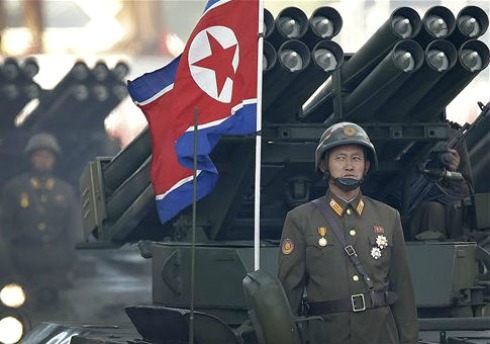Archives
AND MORE...

The Groveling Continues
_____________________

Lies, Damned Lies & BO Lies
_____________________

Here Comes Da Proliferation
_____________________

Anatomy of Incompetence
_____________________

A Very Disturbing Dot
_____________________
February 12, 2016
Another 'Fantastic' Deal
In a report to Congress on Friday, the Pentagon said North Korea poses an increasing danger of using long-range missiles capable of striking the United States with nuclear warheads and is fielding new road-mobile and submarine-launched missiles (see below).
Another fantastic deal. In 1994, the Clinton administration signed a deal with North Korea, in which the regime shut down its plutonium-based facility in Yongbyon and opened it for IAEA inspection.
But then, two years later, it became a nuclear state, and now, with ever-advancing missiles, it threatens others beyond the immediate neighborhood.
And the plutonium-based facility in Yongbyon, which North Korea shut down some 22 years ago? Well, that facility is now being expanded and the plutonium production reactor is being restarted, according to Director of National Intelligence James Clapper's testimony in front of Congress this week.
Iran – whose scientists and technicians have been spotted over the years at North Korean testing sites, including during this week’s North Korean satellite launch – is playing the same game. Iran’s missile program is based on North Korean design and technology.
The UN Security Council is trying to impose new sanctions on North Korea, while a bipartisan group of legislators in Washington is trying to punish Iran for its missile launch in violation of the Iran Deal. All too little, too late.
Moral of the story: Making deals with rogue regimes and pathological liars is never a good thing, and Americans would be better served if they'd bother to learn from history.
Washington Free Beacon | February 12, 2016
Pentagon: North Korea Nuclear, Missile Threat Increasing
Pyongyang shifts policy to building nuclear arsenal
By Bill Gertz

North Korean military. AP
North Korea poses an increasing danger of using long-range missiles capable of striking the United States with nuclear warheads and is fielding new road-mobile and submarine-launched missiles, the Pentagon said in a report to Congress made public Friday.
The Pentagon is working with South Korea, Japan and other countries to counter “the continued and growing threat from North Korea, its nuclear and missile programs, and its proliferation of related technology,” the report said, adding that the U.S. provides “extended deterrence” through both nuclear and conventional forces.
On the nuclear threat, the report singled out missile programs as a major worry.
“North Korea’s continued pursuit of nuclear technology and capabilities and development of intermediate- and long-range ballistic missile programs underscore the growing threat it poses to regional stability and U.S. national security,” the 30-page report states.
“North Korea’s pursuit of a submarine-launched ballistic missile capability also highlights the regime’s commitment to diversifying its missile force, strengthening the missile force’s survivability, and finding new ways to coerce its neighbors.”
North Korea’s submarine-launched ballistic missile (SLBM) program was first disclosed by the Washington Free Beacon. In January, the first successful ejection test of the developmental SLBM was carried out.
Bruce Bechtol, a former Defense Intelligence Agency expert on North Korea, said the SLBM poses an increasing threat of nuclear attack against the United States.
“The SLBM program is scary to me because it has the new, Golf-class submarine, and the ‘new’ SSN-6 missile to successfully threaten American bases and territory,” said Bechtol, a professor at Angelo State University in Texas.
“To discount this ongoing development is to discount the national security of the United States,” he added.
The report said North Korea possesses one submarine-launched missile system, along with less than 100 short-range Scud missiles and fewer than 50 800-mile-range Nodong missiles. An intermediate-range missile also is deployed.
The North Koreans possess an unknown number of long-range TD-2 missiles like the one test-fired last weekend. Additionally, the North Korean military has at least six KN-08 road-mobile missiles. The missile has been ground-tested extensively but has not been flight tested.
Both the Taepodong and KN-08 are assessed as having ranges greater than 3,400 miles.
The regime’s missile forces were upgraded recently with the creation of the North Korean Strategic Rocket Forces.
“North Korea also continues to develop the TD-2, which could reach the continental United States if configured as an [intercontinental ballistic missile],” the report said.
North Korea has said the TD-2 is a space launcher that placed a payload into orbit on Sunday. The report said that without a reentry vehicle capable of surviving the heat of reentry “North Korea cannot deliver a weapon to target from an ICBM.”
The regime of North Korean leader Kim Jong Un also has developed offensive cyber warfare capabilities that are used to “collect intelligence and cause disruption in South Korea and other adversaries including the United States.”
The North Koreans were behind the November 2014 cyber attack against Sony Pictures Entertainment that shut down employee access and deleted data, the report said.
North Korea’s national strategy announced by Kim in 2013 is aimed at building up both its economy and its nuclear forces.
The North is believed to have an arsenal of between 10 and 20 nuclear warheads and has boasted of the capability of launching long-range nuclear missiles.
In September, North Korea announced that nuclear facilities at Yongbyon had been restarted for a nuclear forces buildup.
“The strategic goal of the regime is to ensure Kim family rule in perpetuity,” the report said, adding that Kim, 33, has solidified his grip on power since taking control after the death of his father, Kim Jong Il in late 2011.
North Korea’s pattern of conducting provocative small-scale military attacks combined with its nuclear and missile developments and its arms proliferation “pose a serious threat to the United States, the region, and the world,” the report concluded.
Despite outdated military equipment and arms, the one million-strong army can “inflict serious damage” on South Korea, using thousands of artillery guns and rockets capable of reaching the South Korean capital of Seoul.
The country’s space program appears to be “a veneer” intended to mask the long-range ballistic missile program. The government also announced plans to deploy weather and geostationary satellites.
The test Sunday placed a payload in a polar orbit that nuclear experts say could be used by North Korea to develop a space-based nuclear blast designed to disrupted all electronics in the United States with an electromagnetic pulse.
According to the Pentagon, North Korea does not trust China and Russia and claims to be under imminent threat from outside the country.
The “garrison state worldview” is used to justify draconian security controls and large military expenditures.
“Despite resource shortages and aging equipment, North Korea’s large, forward-positioned military can initiate an attack against the ROK with little or no warning, minimizing the logistics strain it would incur if deploying forces from further away,” the report said.
The regime is unlikely to conduct a large-scale military attack that would invite counterattacks but is willing to use smaller, asymmetric warfare strikes, like the DMZ mining and the Sony cyber attack.
Smaller attacks using special operations forces, growing artillery, and missile forces could rapidly escalate to a larger conflict.
The report said North Korea state-run media revealed an unmanned aerial vehicle that appears to be a copy of the Raytheon MQM-107 Streaker target drone.
“North Korean press coverage of the event described the UAV as being capable of precision strike by crashing into the target,” the report said.
In addition to nuclear forces, North Korea also has biological and chemical weapons arsenals.
On arms proliferation, the report said Pyongyang has continued to sell conventional arms and ballistic missiles that provide a source of hard currency for the internationally isolated regime.
“North Korea uses a worldwide network to facilitate arms sales activities and maintains a core, but dwindling group of recipient countries including Iran, Syria, and Burma,” the report said.
“North Korea has exported conventional and ballistic missile-related equipment, components, materials, and technical assistance to countries in Africa, Asia, and the Middle East.”
The sales were carried out in violation of United Nations sanctions. Pyongyang has used various means to circumvent the sanctions, including the falsification of documents, mislabeling crates, and using front companies to hide the ship and air transfers.
“North Korea’s demonstrated willingness to proliferate nuclear technology remains one of our gravest concerns,” the report said, noting past sales of nuclear goods to Libya and Syria.
International interdictions of North Korean arms transfers included the July 2013 seizure in Panama of air defense systems and MiG-21 jets.
Other North Korean arms shipments were stopped from reaching Burma, Congo, and Syria.
This year’s annual report, required under 2012 legislation, for the first time was 30 pages long and included graphics. Previous reports were limited to one or two pages.
The report “Military and Security Developments Involving the Democratic People’s Republic of Korea 2015,” can be accessed here.
Original article here.
Log In »
Notable Quotables
"Mr. Netanyahu is one of the most media-savvy politicians on the planet. On Friday he appeared live via video link on 'Real Time with Bill Maher,' taking the host’s alternately sardonic and serious line of questioning with gazelle-like alacrity."
~ Anthony Grant, jourrnalist who has written for many major newspapers and worked in television at Paris and Tel Aviv, interviewing former PM Benjamin Netanyahu on Monday, at the outset of Mr. Netanyahu's new book (more here).


